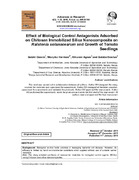| dc.description.abstract | Background: Biological control holds promise in managing bacterial wilt disease. However, its efficacy is limited by harsh environmental conditions when applied without use of suitable carrier materials.
Aim: The study entailed synthesis of nanocarrier materials for biological control agents (BCAs) using Chitosan and silica nanocomposites.
Site and Duration: The experiments were carried out at Jomo Kenyatta University of Agriculture and Technology for a period of two years June 2013 to June 2015. Methodology: The experiments were conducted using a completely randomized design with three replications. Deacetylation, functionalization and immobilization of chitin on mesoporous silica nanoparticles (MSN) to form chitosan immobilized silica nanocomposites (CISNC) gel was done. Results: This resulted in formation of chitosan nanoparticles and CISNC with crystallite sizes of 2.8 and 4.4 nm respectively. BCAs were adsorbed on CISNC gel. Characterization of the bionanocomposites showed that they had physisorption properties thus, ideal carriers for BCAs. CISNC gel had the highest significant (P=.05) sorption properties with 75% and 65% adsorption and desorption respectively of BCAs. Efficacy trials were done by in vitro pathogen inhibition and greenhouse bioassays using tomato seedlings. Adsorption of BCAs on CISNC gel significantly (P=.05) increased inhibition efficacy of BCAs on R. solanacearum from 50 to 70%. This was attributed to the antibacterial effect of the individual substances and the overall synergy acquired. Further, BCA-CISNC gel forms a film around root hairs, initiates fast wound healing mechanism and induce prophylactic effect on tomato seedlings challenged with R. solanacearum pathogen, decreasing wilting incidences from 45 to 25%. Additionally, BCA-CISNC complex significantly (P=.05) increased tomato seed germination from 70 to 80% and growth rate from 12 to 15% due to enhanced water utilization efficiency, induced phytohormones and nutritional benefit. BCAs also aided faster nutrient release, absorption and utilization by tomato plants. Conclusion: Therefore, adsorption of bacterial, fungal and phage biocontrol agents on CISNC gel, a complex hitherto not reported to have been used in R. solanacearum disease control, enhanced microbial efficacy against the pathogen and increased tomato productivity. | en_US |
